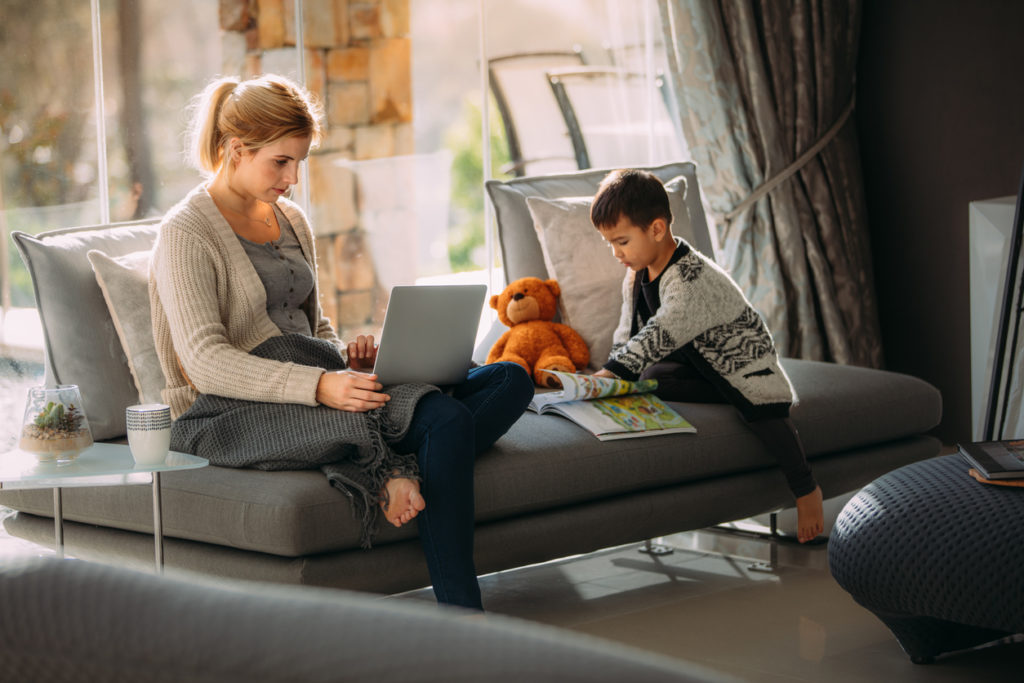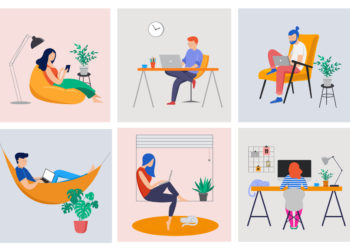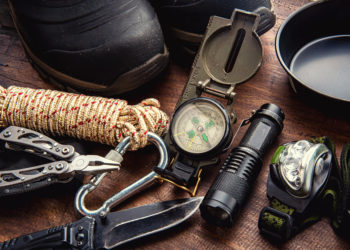In the United States, over the past two weeks, millions of individuals have found themselves working from home, and, for those households with school-aged children, millions have found themselves taking on something between 24/7 childcare and homeschooling. These steps seem necessary to protect public health, but they are impacting the rhythm of our professional and personal lives all at once. Will we end up rethinking the value of face-to-face instruction? Will we be relieved to be able to send our kids back to school and get ourselves back in the office? There are substantial implications for our educational systems, and not incidentally for educational publishing. A group of Chefs today reflects on some of the struggles we are facing, and the lessons we are learning, about parenting during the pandemic.

David Crotty
Our local district had a school bus driver test positive for coronavirus almost three weeks ago, so we’re probably a little ahead of most in the US as we’ve been off since then, with “distance learning” already underway. While at first it seemed reasonable to treat these days off as a “snow day”, we’ve come to realize that we need to be in this for the long haul, as social distancing may need to last through the end of the school year. It’s become increasingly clear that our entire family works best when we have a clear and regular schedule to follow. There’s a good article in The Washington Post about this, and sticking to regular bedtimes and mealtimes makes a huge difference as far as feeling like the days aren’t just drifting by unproductively.
Having school back in session remotely has also been a boon as far as keeping a regular schedule. Most schools are still figuring things out, so be patient and be prepared to track a lot of different emails from different teachers to put together a coherent class schedule and list of homework assignments. Each teacher seems to have a different level of comfort with technology and presenting this way, so your mileage may vary. Zoom seems a little slow, but is holding up so far, and after an initial few sessions of the entire class needing to talk at once, things have settled into a groove. One of the interesting lessons has been the school figuring out proper online etiquette, and sending around a set of rules (e.g., no custom Zoom backgrounds, the school dress code is still enforced, and perhaps most importantly, no cell phone use during a class session). A quick lesson in using Zoom’s “raise hand” function was important as well (click on “Participants” and a side window opens up with a button for this).
Though I’m generally used to working from home, the big difference for me has been working from home with everyone else home as well. Scheduling is just as important for the adults in the house as it is for the children. Carve out times when you’re working and shouldn’t be disturbed. Sequestering yourself off in a private space is necessary, as is this list of tips on not driving your partner crazy, and not taking someone else’s need for space as a personal insult.
One last thought – don’t neglect recess! Get outside if you can, go for a walk, go shoot some baskets at a local court, or just run around the yard/block. Social distancing can feel claustrophobic if you’re within the same walls 24 hours a day, but there’s plenty you can do that’s outside and fun that doesn’t put you or others at risk. Kids need to move their bodies, and so do adults.
Karin Wulf
I’m seeing virtual learning from two new perspectives, as I work with the teachers at my son’s special-needs high school to implement the curriculum he needs to graduate this year, and as I modify my graduate seminar at William & Mary. His school had a last half day on Friday, and is on a bit of hiatus for the first few days of this week as teachers get sorted out. Our university campus was on spring break last week, all classes are suspended this week and resume as online-only next week. So it’s a week of getting adjusted.
It’s a little head-snapping in some ways, but in others a good reminder that basic best practices really are best for everyone: clarity of information and priorities, accessibility of materials (usually meaning lowest tech possible to reach everyone), and a sense of collaborative effort and engagement. Interestingly, both my son’s high school classes and my graduate seminar have a core of course content already online, and we’d both used online tools. In his case they use Google Classroom and another educational platform for communicating across classes. In mine, we use Blackboard for basics (syllabus and some readings are posted, an email originator) and Google Docs for both individual and collectively generated responses to the weekly reading. So we’re not starting from scratch.
Even though this is an adjustment week, my son’s teachers are already providing new material, building on the structures they already had in place. I’m still working out the revision to my own syllabus but am absolutely being instructed by those teachers and their “build on” rather than “completely rebuild” approach. For example, a really big part of graduate school is learning to develop a community around the intellectual issues and challenges of the field. In addition to teaching a graduate seminar, I also advise doctoral students. We usually meet in research workshops, formal or informal, several times a month. To try and provide some sense of community during this strange neverworld of distance, we’re trying out a weekly Friday late afternoon Zoom that will be very casual. One person will share a bit of research in progress and we’ll discuss. I’m going to see whether I can similarly institute something low key with my seminar students.
While he’s learning and I’m teaching we also needed to sort out workspace. Setting up something that would provide him with some consistency and reliability is important given his disability. I can’t be sure that the wifi will be perfectly consistent, or that we won’t have other tech issues. But we could make sure he has his own clean and well lit workspace, with his books and other physical materials organized. Turns out (best practices) of course that’s what I need, too. So, adapting and building on what we’ve got rather than completely rebuilding, keeping goals in mind, that’s our guidestar!
Angela Cochran
Late Monday afternoon, all the signs were there. School superintendents and mayors using words like “for the foreseeable future” when talking about schools and other shuttered institutions, or keeping their optimistic open dates with the caveat of “will reassess as the time gets closer.”
Our kids are never going back to school this year. With a full quarter and then some left, I am starting to come to terms with my kids being home until school starts next August. I was already stressing out about the summer as my kids are too old for a sitter and most camps, but too young to be home alone, together, all the time.
Immediately upon the news of school closings, parents in my network (mostly Facebook) were sharing resources and tips. Educational Online Services were dropping subscriptions and offering us a lifeline. Our school district, one of the largest in the country, was not ready. A planned teacher work day thought to give them time to prepare packets and assignments was canceled with the earlier than they expected school closing. We are, for the next few weeks, on our own.
With all these great online learning resources, early Sunday morning I started a Facebook group so my parent friends and I could share what we were finding. As of Wednesday evening, there are over 1100 members. Parents with kids of all ages, from all over the country.
My evenings now include 1-2 hours of prep time — making a schedule in a Google Doc for each kid with online assignments mixed in with exercise, reading, art, and their favorite…mystery hour! Are they learning? Yes. Are they following the school curriculum? Not at all.
It does seem that our school district intends to offer distance learning at some point. They were prepared to distribute laptops and MiFi devices to kids who need them this past Monday, but those plans were scrapped when access to the school buildings was shut down. Grab-and-go breakfast and lunch is being provided to kids that need it from several school locations. Parents can buy themselves the meal for $2. Feeding at-risk families is obviously going to be more important than making sure my kids get distance learning opportunities.
So today, I am grateful that scientists are doing live science hour on Facebook, that children’s authors like Mo Willems and Jarrett J. Krosoczka are giving live art lessons every day on YouTube, and that Khan Academy exists and is free; but, I worry that this won’t be sustainable “for the foreseeable future.”
Roger Schonfeld
Our elementary and middle school aged kids were given off last Tuesday for a “deep cleaning” of the school following another pupil’s relative being exposed, were back in school on Wednesday, and then the school determined it would close for Thursday and Friday on a precautionary basis. We elected to keep our pre-K child home on Thursday and Friday as well. School is now off this week and the following four weeks, at a minimum. I will be surprised if there is any more face-to-face education for the duration of the academic year.
For the older kids, we are still in what was to have been spring break, so there are no structured assignments, let alone anything resembling instruction. We made an emergency investment in Kindles, and Amazon’s FreeTime Unlimited library has given them plenty to read. I never took to a Kindle myself, and I’m impressed at how immediately comfortable they are with these reading devices.
We’ll see soon enough what kind of online learning their school will offer. During the school year, the middle schooler has been using the learning management system Schoology, to access and submit homework assignments, as well as some adaptive learning systems, for example for math practice. I am not sure if we can expect a shift to truly online instruction or rather an expansion in assignments delivered through these platforms already in use. For both school-aged children, I worry about what they will miss in social connections in a time of physical isolation, as well as whether they can continue to progress skill building in areas such as analytical and critical thinking.
The real wildcard is our pre-K child, who is beginning to read but not able to occupy herself consistently. We are overusing the TV as a way to keep her occupied so that we can work. That is certainly not a long-term solution for her development, and it also has a gravitational pull as a major distraction for the older kids. Today, she had a Zoom meeting with others from her pre-K class. If you think that learning the etiquette of a large-group video conference is complicated for you, imagine trying to get a group of 4 and 5 year olds to wait their turn to speak!
Some positives are clear. We don’t have the stresses of racing to make it to the school bus in the morning, and we don’t have a narrow window for homework/catch-up/dinner in the evenings. And, it’s been a joy to spend a few minutes here and there with the kids between meetings and calls. We may be isolating in a city apartment, but, so far, we’ve been incredibly fortunate.
Lettie Conrad
Like many private and public school districts in California and other regions impacted by Covid-19 cases, the middle school where my husband teaches is closed this week. While the district has only announced week-by-week decisions, we assume all our area schools will be out of commission for the next few months. Our region is very diverse and I trust that some students are having learning experiences similar to those shared by my home-schooling parenting Chef colleagues here. However, situated in a socio-economic disadvantaged city, it is important to keep in mind that students like my husband’s are missing meals more than their math lessons.
This is a school with 100% free breakfast and lunch programs — that’s ~65% of students’ daily food. Therefore, a top order of business for closing these schools was transforming 3 of the district’s campuses into community feeding centers for children ages 1-18. When teachers were notified on Friday morning that school would be closed this week, they were strictly instructed to not assign homework during this period and not to facilitate remote instruction or other points of contact. Although iPads have been issued to all grades, not all students have equal internet access, quiet study spaces, and other factors required for successful learning.
My husband and I know that these students do not have the home and community resources that we grew up with, a reality he faces at school every day, but these imbalances are especially poignant and obvious this week. Most parents in this district are in minimum wage jobs, some of which are at risk (e.g., retail customer service, house cleaning, etc.) and some of which are compelled to stay home to provide childcare to students out of school. Those who can still work are likely carrying on as much as they can, to keep incoming flowing, even if that means leaving kids at home alone.
We imagine my husband’s students are spending most of the time off this week at home on their phones, playing video games, texting friends, and connecting on social media. And we assume that many teachers in this district are dealing with their own family contingencies, home schooling, etc. Some teachers are working from home this week to coordinate contingency plans with administrators (who, along with classified staff, are required to come to school) — for example, for my husband’s journalism elective, what to do about the yearbook-in-progress? Without student involvement, will we have time to produce something worthwhile? And will students’ families be able to afford them this year?
Crises like this one puts priorities in stark relief, but decisions are really tough ones — teachers have been told the California Assessment of Student Performance and Progress (CAASPP) is in jeopardy, a standard that provides the basic framework for instruction and grade progression. This is chilling stuff for districts like my husband’s — how do we reimagine distance learning for K-12 students in socio-economic deprived regions? Even with free wifi for a period of time, how do we best care for these students and their families remotely, as we retool how we provide educational and community services going forward?
Tao Tao
The school district where I live decided to offer no online learning program since not everyone has internet access, and the school closure only started yesterday, so I have little personal experience to share. However, my Chinese cousins have been through this for a while now and have quite a lot to share.
Lockdowns started with Wuhan and were soon imposed nationwide in China right before the Chinese New Year, also at the beginning of school winter break. When the winter holiday ended on February 17, still closed, some K-12 schools started to try teaching online using Tencent Meeting Room which waived all charges during the pandemic, also social media tools like QQ or WeChat for group discussion and collection of homework. With no definite answer to when the schools will be opened again, the government took over the matter in March. In my hometown Chengdu, thirteen TV channels were assigned to each grade for online teaching. Teachers from the best schools in the city give lectures on TV. Each class lasts from 20 minutes for 1st Graders to 45 minutes for high schoolers. There are breaks between the classes, to follow real school agendas. Children could use other devices like computers or iPads for the classes, but TV resolves the problem of students in remote areas with poor internet connectivity. Local school teachers then hold small-group conference calls with their students to answer questions and help with homework. Teaching plans are published weekly so all students and teachers are following the same schedule. Such a class could have 160,000 students online at the same time.
It all sounds very organized and neat, but how does it work in reality? Here’s what I’ve heard from students and parents:
My cousin has a daughter in 1st grade who cannot sit through 20 minutes in front of a screen, so she has to sit with her in every lesson. Fortunately she works part-time from home, but for many families where both parents have to go to work, this task falls to the grandparents who find it especially challenging. Even if the parents have time and wholeheartedly take the responsibility as a home-schooler, they find it very hard because the children doubt their authority and don’t follow their instruction. My cousin said she would spend 10 minutes asking her daughter to do something that the teacher could make the girl do with a single sentence. I asked her how many hours daily she has to spend helping her daughter learn remotely, and she said she feels it’s all day long.
My niece who is in 9th grade also has a lot to say. A big problem is that each teacher only lectures on TV for one week, then passes to another for the next week. Just when my niece and her classmates are used to a teacher’s style, they meet another new teacher. The teachers also need time to get used to it. One teacher finished a lesson in 10 minutes that was supposed to last 40 minutes. Being aware that the teacher cannot see her, my neice found it harder to concentrate. There are advantages of online lessons that she really likes. She is able to listen to some of the country’s best teachers’ lectures and has found them really enlightening. Also, while it’s harder to take notes (since the lecturers do not know the audience’s reactions, they tend to speak faster), she can always replay and take screenshots. The disadvantage is that she has to use electronic devices which are distracting. After a few weeks’ online learning, she really misses the real classrooms (and I bet her friends in school).
Finally let’s hear what her Mother has to say — Her big task is to take short videos of her daughter learning and practicing (including PE), and upload to the class group chat. That’s a way for schools to ensure parents participate and monitor their children’s study. Her other concern is her daughter spending too much time on screens which worsen her eyesight. There are also other concerns/accidents. Since many children use their parents’ mobile devices, some found a way to purchase online games and spent a big chunk of money before their parents noticed. So parents, keep an eye on your bank account if you’re sharing a device!
We hope this has been helpful for any parents who, like us, are still figuring out this new (and hopefully temporary) way of living. Let us know your lessons learned in the comments below.
Discussion
6 Thoughts on "Parenting School Aged Children Through a Pandemic"
Thank you all! Very useful tips and insightful as the UK shuts schools everywhere next week, we will feel the brunt of it next week.
Rather than feeling even more burdened by the idea that I’m responsible for “everything” and sometimes failing at all of it, which I think many parents can relate to, I’m trying to accept that I just have to try to get some work done, try to get my kids to engage their brains some of the time, get them outside now and then, etc. I’m incredibly fortunate to be able to work from home, and spending the last few days at home with them has been calmer and at moments more fun than I would have expected, but maybe that’s the point–I didn’t expect to be in this situation, and I didn’t have any expectations beyond making it to the other side at some point. Knowing that many other parents in my various communities are figuring it out at the same time makes every day that much easier.
Thanks for these perspectives! I’ve been very impressed with how quickly our small-town school district organized distribution of free/reduced cost meals, as well as Chromebooks, for those who need them. Lucky for me, my daughter is a high-school senior who is very used to online learning and who needs little help from me, other than the occasional prodding to get off her phone and get back to work. The saddest part, though, is that she most likely won’t have a graduation ceremony. I’ll understand if it doesn’t happen, but it still stings.
I just have to say: That image of 4-5 year-olds on a Zoom call absolutely made my afternoon. Thanks for all the insight as we struggle through together.
thanks all for sharing these useful insights and experiences … as well as the online school learning (here my 9-year-old son gets his assignments at 9am, and is usually done by 10.30am, then there’s a fun Google class hangout in the afternoon, which certainly stimulates a sense of community, and excitement with introductions to classmates pets, siblings etc) …
However, if this remote learning is to go for a period of time, which we all suspect it is, I wonder if we as parents and educators need to think about engagement in the kids’ own environment too … learn what stimulates the kids on games like Minecraft, and then set stimulating challenges for them, in these environments, bring the class room to them … my son has built libraries, houses, and communities with his friends in Minecraft, and now thinks more about sustainability, community, and safety … we’ve also encouraged him to do a ‘teach the parents’ Minecraft (he learns a lot by watching YouTube videos on Minecraft by the way) … he is interested in creating his own educational YouTube videos (if you ask kids what they want to do as a career, many will answer, be a professional YouTuber) …
We are still in the early stages of developing these interactions, ideas, and ways to educationally stimulate, and learn important life lessons … but I hope this might be food for thought for a few, perhaps there are ultimately business applications here too to inspire the new generation of learners, researchers and readers, and that others may share similar experiences in a collaborative way.
Thanks also Chefs for keeping posting really useful and relevant topics on the Kitchen during these busy times … you are real heroes too!


